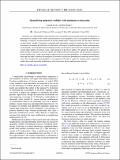Quantifying epigenetic stability with minimum action paths
Author(s)
Sood, Amogh; Zhang, Bin
DownloadPublished version (563.5Kb)
Publisher Policy
Publisher Policy
Article is made available in accordance with the publisher's policy and may be subject to US copyright law. Please refer to the publisher's site for terms of use.
Terms of use
Metadata
Show full item recordAbstract
© 2020 American Physical Society. Chromatin can adopt multiple stable, heritable states with distinct histone modifications and varying levels of gene expression. Insight on the stability and maintenance of such epigenetic states can be gained by mathematical modeling of stochastic reaction networks for histone modifications. Analytical results for the kinetic networks are particularly valuable. Compared to computationally demanding numerical simulations, they often are more convenient at evaluating the robustness of conclusions with respect to model parameters. In this communication, we developed a second-quantization-based approach that can be used to analyze discrete stochastic models with a fixed, finite number of particles using a representation of the SU(2) algebra. We applied the approach to a kinetic model of chromatin states that captures the feedback between nucleosomes and the enzymes conferring histone modifications. Using a path-integral expression for the transition probability, we computed the epigenetic landscape that helps to identify the emergence of bistability and the most probable path connecting the two steady states. We anticipate the generalizability of the approach will make it useful for studying more complicated models that couple epigenetic modifications with transcription factors and chromatin structure.
Date issued
2020Department
Massachusetts Institute of Technology. Department of ChemistryJournal
Physical Review E
Publisher
American Physical Society (APS)